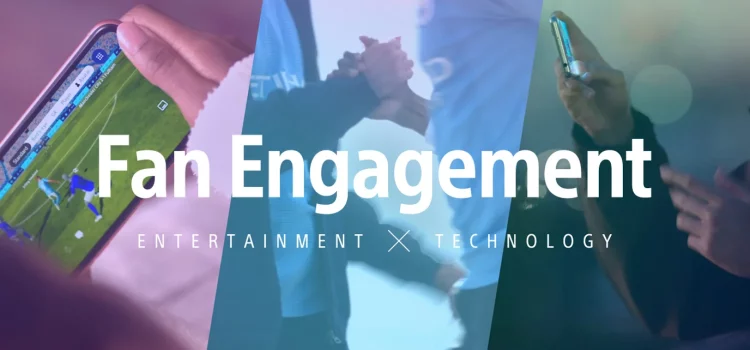
Introduction
In today’s world, technology plays a significant role in shaping how fans engage with their favorite sports teams, celebrities, and brands. Gone are the days when fan engagement was limited to in-person interactions or traditional forms of communication like fan mail or TV broadcasts. Today, digital platforms, social media, and cutting-edge technologies provide fans with unprecedented opportunities to connect, share, and participate in a more immersive and personalized way. This article will explore how technology has transformed fan engagement, the tools driving these changes, and the impact of these innovations on brands, sports, and entertainment industries.
What is Fan Engagement?

Fan engagement refers to the emotional connection and interaction that a fan has with a brand, team, or celebrity. It involves more than just passive consumption of content—it includes active participation, feedback, and a sense of belonging. Engaged fans are not only loyal, but they are also more likely to promote the brand or team through word-of-mouth and social media sharing, thus enhancing the reach of the brand. Fan engagement can be fostered through events, social media campaigns, personalized experiences, and much more, with technology being the key enabler of these interactions.
Rise of Technology in Cultivating Fan Engagement
Technology has seen a significant rise in shaping how fans interact with their favorite teams, celebrities, and brands. Social media, augmented reality (AR), virtual reality (VR), and data analytics have become key tools in creating immersive and personalized experiences that go beyond traditional methods. This rise has allowed fans to engage actively and continuously with their interests, blurring the lines between the virtual and physical worlds.
Benefits of Technology in Cultivating Fan Engagement
The use of technology has numerous benefits in cultivating fan engagement. It enables real-time communication between fans and teams or celebrities, fostering a sense of connection. Personalized content and experiences ensure that fans feel valued, while tools like AR and VR allow for immersive, interactive experiences that make fans feel part of the action. Additionally, data-driven insights help brands understand fan behavior and preferences, allowing them to tailor content and offers to keep fans engaged.
The Role of Technology in Cultivating Fan Engagement

Technology plays a central role in enhancing fan engagement by breaking down barriers between fans and brands. Through social media, fans can interact directly with teams and celebrities, share content, and participate in real-time discussions. AR and VR experiences create immersive environments where fans can feel like they’re part of live events, while gamification elements, like challenges and rewards, encourage ongoing interaction. These technologies enable fans to stay connected and actively participate in a brand’s story, fostering deeper loyalty and connection.
How Technology Enhances Fan Engagement

1. Social Media and Direct Communication
Social media platforms like Twitter, Instagram, TikTok, and Facebook have revolutionized how fans interact with their favorite celebrities, brands, and teams. These platforms provide real-time communication, where fans can directly message their idols or teams, comment on posts, and share content. The immediacy of this communication builds a stronger emotional connection. Additionally, the use of live streaming features allows fans to participate in events in real-time, giving them an interactive experience rather than simply being spectators.
2. Data and Personalization
Technology has enabled the collection of vast amounts of data that provide insights into fan behavior and preferences. Sports teams, entertainment brands, and even streaming platforms use this data to create personalized content that speaks directly to individual fans. This could be as simple as sending out birthday wishes or offering special discounts based on purchase history. Personalized experiences ensure fans feel seen and valued, thus encouraging deeper loyalty and engagement.
3. Augmented and Virtual Reality
Augmented Reality (AR) and Virtual Reality (VR) are rapidly transforming fan engagement by creating immersive experiences. For instance, sports fans can now attend virtual games in VR, making them feel as if they are sitting in the stadium, despite being miles away. In the entertainment world, AR filters on social media allow fans to interact with characters from their favorite shows or movies. This form of engagement makes fans feel like they are part of the action, blurring the lines between the virtual and real worlds.
4. Gamification
Gamification is the process of integrating game-like elements, such as points, challenges, and rewards, into non-game environments. This has been successfully used to boost fan engagement in a variety of industries. For example, sports apps allow fans to predict match outcomes, earn rewards for interacting with content, or participate in fantasy leagues. These elements keep fans engaged and motivate them to stay connected with their favorite teams or brands regularly.
5. Fan-Centric Apps and Platforms
Many teams, brands, and events now offer dedicated apps or platforms that serve as hubs for fan engagement. These apps provide fans with exclusive content, behind-the-scenes access, and the ability to participate in polls, contests, and interactive experiences. For example, many sports teams use apps to give fans live updates, video highlights, and a platform to interact with each other in chatrooms. These fan-centric platforms have become essential in maintaining ongoing engagement.
Technology in Sports: A Case Study

One of the most prominent industries benefiting from fan engagement technology is sports. Teams and leagues around the world are adopting technology to create stronger connections with their fans. For instance, the National Football League (NFL) and Major League Soccer (MLS) have implemented in-app ticketing, real-time stats, and social media integration to improve fan experience. Fans can now access exclusive content, engage with other fans globally, and even vote for their favorite players to receive awards.
One noteworthy example is the NFL’s use of augmented reality. Fans attending live games can use their smartphones to access AR experiences that provide additional player stats, team information, and interactive elements that enhance their live experience.
Social Media’s Impact on Fan Engagement

Social media has become one of the most powerful tools for fan engagement. Platforms like Instagram, Twitter, TikTok, and Facebook allow fans to connect directly with their favorite celebrities, teams, and brands. Fans can comment on posts, share their opinions, and even send messages to the people they follow. This direct communication builds stronger relationships, as fans feel heard and valued. Social media also lets fans stay updated on news and events in real time, creating an ongoing connection that wasn’t possible before.
The Impact on Brands and Businesses

For businesses, cultivating fan engagement is crucial for building loyalty and increasing revenue. Engaged fans are more likely to make purchases, subscribe to services, and recommend products to others. Moreover, fan engagement leads to valuable data that can help businesses refine their marketing strategies, tailor products to meet consumer preferences, and create long-term relationships with their audiences.
Balancing Technology with Real-Life Experiences
While technology has enhanced fan engagement, it’s important not to forget the value of real-life experiences. Attending a live event, meeting a celebrity, or watching a game in person is something that technology cannot fully replace. However, technology can complement these experiences by providing fans with extra content and interactive opportunities. For example, fans attending a concert might use an app to access exclusive behind-the-scenes videos, interact with other fans, or access AR filters. The key is to strike a balance between digital engagement and in-person experiences, ensuring fans feel connected both online and offline.
Fan Engagement in the Entertainment Industry

The entertainment industry has also embraced technology in cultivating fan engagement. Streaming platforms such as Netflix and Disney+ use advanced algorithms to recommend content based on viewers’ preferences, ensuring that fans discover new shows and movies they’ll enjoy. Social media platforms like Instagram and Twitter allow actors, directors, and influencers to engage with their followers by posting behind-the-scenes content, personal stories, and sneak peeks into upcoming projects.
Furthermore, fan conventions like Comic-Con have adopted digital tools to offer fans virtual panels, merchandise, and meet-and-greets with their favorite stars. This has allowed fans from all over the world to participate in these events without physically being present, increasing accessibility and engagement.
Challenges of Technology in Cultivating Fan Engagement
Despite its many benefits, technology also comes with challenges. Privacy concerns are a major issue, as fans may not want their data collected and used for personalized content. The fast-paced nature of technology can also create a learning curve for both fans and brands, making it difficult to keep up with new tools and trends.
Additionally, not all fans have equal access to technology, which can create disparities in engagement opportunities. Ensuring an inclusive approach and addressing these challenges is key to maximizing the impact of technology on fan engagement.
The Future of Fan Engagement

As technology continues to evolve, so too will the ways in which brands, teams, and celebrities interact with their fans. Artificial intelligence (AI) and machine learning will continue to refine the personalization of fan experiences, allowing brands to anticipate fans’ needs and preferences even before they express them. Moreover, blockchain technology is poised to revolutionize fan engagement by offering ways for fans to buy, sell, or trade collectibles like digital autographs, merchandise, or NFTs (non-fungible tokens), creating a new economy for fan interactions.
The continued growth of immersive experiences through AR and VR will offer even more opportunities for fans to engage in virtual worlds and interact with their favorite brands in a meaningful way. Fans will likely become increasingly involved in decision-making processes, such as voting for award winners, choosing the next concert setlist, or influencing team strategies through fan-driven analytics.
Comparative Table: Traditional vs. Technology-Driven Fan Engagement
| Traditional Fan Engagement | Technology-Driven Fan Engagement |
|---|---|
| In-person events and games | Live-streaming and VR experiences |
| Fan mail and letters | Direct messages via social media platforms |
| TV broadcasts and radio shows | Personalized content via apps and streaming platforms |
| Limited access to behind-the-scenes content | Exclusive behind-the-scenes access through apps and social media |
| Word-of-mouth promotion | Social media sharing, hashtag campaigns |
| Fan clubs and forums | Online communities and fan-driven content creation |
Analysis Table: Technology’s Impact on Fan Engagement
| Technology | Impact on Fan Engagement | Example |
|---|---|---|
| Social Media | Enhances direct communication and real-time interaction | Twitter Q&A sessions with celebrities |
| Data and Personalization | Creates tailored experiences based on individual fan behavior | Netflix personalized content recommendations |
| AR/VR | Offers immersive and interactive experiences | VR sports viewing, AR filters on Instagram |
| Gamification | Increases participation and rewards engagement | Fantasy sports leagues, team prediction apps |
| Fan-Centric Platforms | Provides exclusive content and fan community spaces | Sports team apps offering live updates and rewards |
Conclusion
Technology has completely revolutionized fan engagement, providing fans with exciting and immersive ways to interact with their favorite teams, brands, and celebrities. From social media and data-driven personalization to AR/VR experiences and gamification, the possibilities for fan interaction are endless. As the digital landscape evolves, so too will the methods of fostering deeper connections with fans, making them feel more valued and involved than ever before. In turn, brands, sports teams, and entertainment giants will continue to benefit from increased loyalty, higher engagement, and more personalized experiences that drive long-term success.










